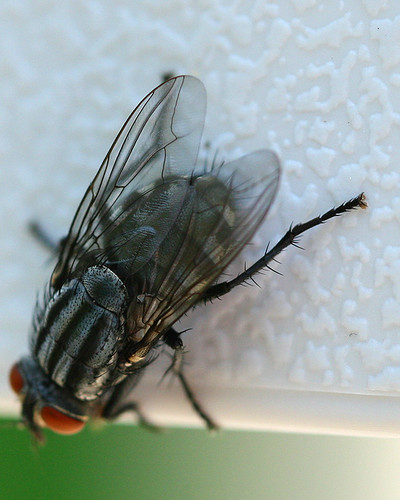Sarcophaga sp. - not your average fly
Sunday, June 18, 2006
The natural world is the best and most therapeutic classroom. When I was a kid I loved sitting next to a plant and sketching it. It really got me in touch with all the minute details and helped me appreciate nature's complexity and flexibility.I think an important lesson that can come from observing nature is to get a better intuitive understanding of evolution. Living things are the way they are because they became that way versus simply being that way. A child can see that a plant can be perfect in it's symmetry and can be a textbook demonstration of that species but also that a different specimen can be imperfect and one can see how the plant's systems failed in some way.
For those who are not inclined to sit in the hot sun and humidity with pencil and paper, the camera can be an amazing resource for capturing nature.
This morning I caught this little fly outside sipping the morning dew in the shade. He or she is beautiful up close and not a pest at all.

You might notice that our photo shows a fly with 3 stripes on his back while many of the shots I find online of house flies have 4 stripes. Ours is actually a Flesh Fly (Sarcophaga sp.). We have a horse stable near our house so I am guessing this came from there. I used blood meal to fertilize our organic garden pots so they must be going to town on bits of that.

Information on the flesh fly can be found at these links:
Identification by Thomas Pape, Curator Ph.D. Zoological Museum, University of Copenhagen
British Insects: the Families of Diptera
National Center for Biotechnology Information Taxonomic Data
The full lineage of this fly is:Eukaryota; Fungi/Metazoa group; Metazoa; Eumetazoa; Bilateria; Coelomata; Protostomia; Panarthropoda; Arthropoda; Mandibulata; Pancrustacea; Hexapoda; Insecta; Dicondylia; Pterygota; Neoptera; Endopterygota; Diptera; Brachycera; Muscomorpha; Schizophora; Calyptratae; Oestroidea; Sarcophagidae; Sarcophaginae; Sarcophaga
Flesh Fly Wikipedia Entry
For things to learn about the common house fly or Musca domestica Linnaeus, see these links:
Common House Fly at Enchanted Learning
This site has this lovely drawing
House Fly Wikipedia entry
House Fly life cycle(Image source: Novartis)
National Center for Biotechnology Information Taxonomic Data
This site tells us that the full lineage of the house fly is:Eukaryota; Fungi/Metazoa group; Metazoa; Eumetazoa; Bilateria; Coelomata; Protostomia; Panarthropoda; Arthropoda; Mandibulata; Pancrustacea; Hexapoda; Insecta; Dicondylia; Pterygota; Neoptera; Endopterygota; Diptera; Brachycera; Muscomorpha; Schizophora; Calyptratae; Muscoidea; Muscidae; Muscinae; Muscini; Musca; Musca
8:42 AM :: 0 comments
Post a Comment
nika :: permalink
>0 Comments:
Post a Comment
<< Home
nika :: permalink


